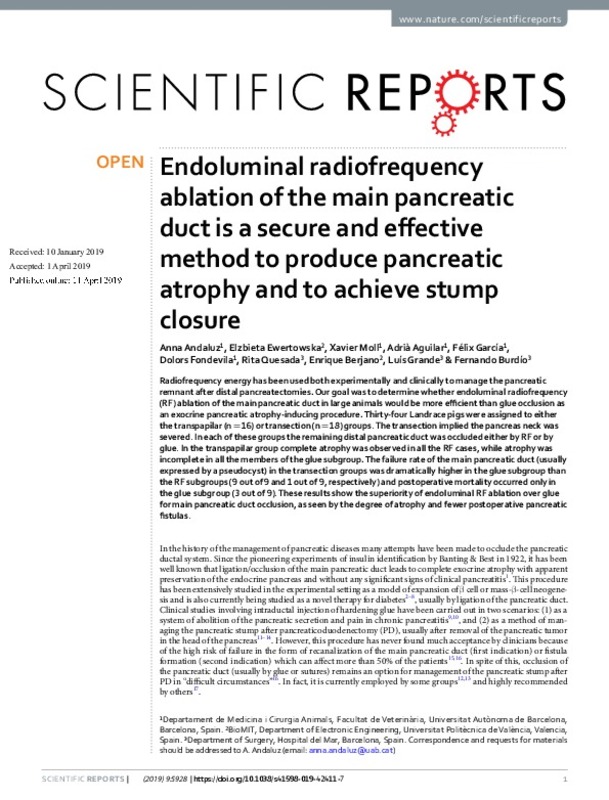Howard, J. M. History of the Pancreas. Mysteries of a Hidden Organ. (New York: Kluver Academic, 2002).
Cai, Y. et al. IL-6-dependent proliferation of alpha cells in mice with partial pancreatic-duct ligation. Diabetologia. 57(7), 1420–1427, https://doi.org/10.1007/s00125-014-3242-8 (2014).
De Groef, S. STAT3 modulates β-cell cycling in injured mouse pancreas and protects against DNA damage. Cell Death Dis. 7(6), e2272, https://doi.org/10.1038/cddis.2016.171 (2016).
[+]
Howard, J. M. History of the Pancreas. Mysteries of a Hidden Organ. (New York: Kluver Academic, 2002).
Cai, Y. et al. IL-6-dependent proliferation of alpha cells in mice with partial pancreatic-duct ligation. Diabetologia. 57(7), 1420–1427, https://doi.org/10.1007/s00125-014-3242-8 (2014).
De Groef, S. STAT3 modulates β-cell cycling in injured mouse pancreas and protects against DNA damage. Cell Death Dis. 7(6), e2272, https://doi.org/10.1038/cddis.2016.171 (2016).
Hao, E., Lee, S. H. & Levine, F. Efficient β-cell regeneration by a combination of neogenesis and replication following β-cell ablation and reversal of pancreatic duct ligation. Stem Cells. 31(11), 2388–2395, https://doi.org/10.1002/stem.1492 (2013).
Chung, C. H., Hao, E., Piran, R., Keinan, E. & Levine, F. Pancreatic β-cell neogenesis by direct conversion from mature β -cells. Stem Cells. 28(9), 1630–1638, https://doi.org/10.1002/stem.482 (2010).
Cavelti-Weder, C. et al. Pancreatic duct ligation after almost complete β-cell loss: exocrine regeneration but no evidence of β-cell regeneration. Endocrinology. 154(12), 4493–4502, https://doi.org/10.1210/en.2013-1463 (2013).
Xu, X. et al. Beta cells can be generated from endogenous progenitors in injured adult mouse pancreas. Cell. 132(2), 197–207, https://doi.org/10.1016/j.cell.2007.12.015 (2008).
Rankin, M. M. et al. β-Cells are not generated in pancreatic duct ligation-induced injury in adult mice. Diabetes. 62(5), 1634–1645, https://doi.org/10.2337/db12-0848 (2013).
Rösch, W., Phillip, J. & Gebhardt, C. Endoscopic duct obstruction in chronic pancreatitis. Endoscopy. 11(01), 43–46, https://doi.org/10.1055/s-0028-1098323 (1979).
Schneider, M. U. et al. Whipple’ s procedure plus intraoperative pancreatic duct occlusion for severe chronic pancreatitis: clinical, exocrine, and endocrine consequences during a 3-year follow-up. Pancreas 2(6), 715–726 (1987).
Tran, K. et al. Occlusion of the pancreatic duct versus pancreaticojejunostomy: a prospective randomized trial. Ann Surg. 236(4), 422-8; discussion 428. https://doi.org/10.1097/01.SLA.0000029244.62872.97 (2002).
Theodosopoulos, T. et al. Pancreatic remnant occlusion after Whipple’s procedure: an alternative oncologically safe method. ISRN Surg. 2013, 96042, https://doi.org/10.1155/2013/960424 (2013).
Alfieri, S. et al. Long-term pancreatic exocrine and endometabolic functionality after pancreaticoduodenectomy. Comparison between pancreaticojejunostomy and pancreatic duct occlusion with fibrin glue. Eur Rev Med Pharmacol Sci. 22(13), 4310–4318, https://doi.org/10.26355/eurrev-201807-15427 (2018).
Alfieri, S. et al. Indications and results of pancreatic stump duct occlusion after duodenopancreatectomy. Updates Surg. 68(3), 287–293, https://doi.org/10.1007/s13304-016-0384-x (2016).
Reissmann, M. D. et al. Pancreaticojejunostomy versus controlled pancreaticocutaneous fistula in pancreaticoduodenectomy for periampullary carcinoma. Am J Surg 169(June), 585–588 (1995).
Fromm, D. & Schwarz, K. Ligation of the pancreatic duct during difficult operative circumstances. J Am Coll Surg. 197(6), 943–948, https://doi.org/10.1016/S1072-7515(03)00793-2 (2003).
Goldsmith, H. S. Pancreatic duct ligation: An idea revisited. J Am Coll Surg. 217(3), 560–562, https://doi.org/10.1016/j.jamcollsurg.2013.06.001 (2013).
Blansfield, J. J. A. et al. Novel method of stump closure for distal pancreatectomy with a 75% reduction in pancreatic fistula rate. J Gastrointest Surg. 16(3), 524–528, https://doi.org/10.1007/s11605-011-1794-1 (2012).
Dorcaratto, D. et al. Radiofrequency is a secure and effective method for pancreatic transection in laparoscopic distal pancreatectomy: results of a randomized, controlled trial in an experimental model. Surg Endosc. 27(10), 3710–3719, https://doi.org/10.1007/s00464-013-2952-1 (2013).
Quesada, R. et al. Radiofrequency pancreatic ablation and section of the main pancreatic duct does not lead to necrotizing pancreatitis. Pancreas. 43(6), 1–7, https://doi.org/10.1097/MPA.0000000000000156 (2014).
Quesada, R. et al. Long-term evolution of acinar-to-ductal metaplasia and β-cell mass after radiofrequency-assisted transection of the pancreas in a controlled large animal model. Pancreatology. 16(1), 38–43, https://doi.org/10.1016/j.pan.2015.10.014 (2016).
Burdío, F. et al. Radiofrequency-induced heating versus mechanical stapler for pancreatic stump closure: in vivo comparative study. Int J Hyperth. 32(3), https://doi.org/10.3109/02656736.2015.1136845 (2016).
Caceres, M., Quesada, R., Burdio, F. & Iglesias, M. Pancreatic duct ligation in a Kras murine model of pancreatic adenocarcinoma reduces the number and the risk of appearance of premalignant lesions over time. Pancreatology. 17(3), S6, https://doi.org/10.1016/j.pan.2017.05.019 (2017).
Braithwaite, B. et al. Radiofrequency-induced thermal therapy: Results of a European multicentre study of resistive ablation of incompetent truncal varicose veins. Phlebology. 28(1), 38–46, https://doi.org/10.1258/phleb.2012.012013 (2013).
Lane, T. et al. A multi-centre randomised controlled trial comparing radiofrequency and mechanical occlusion chemically assisted ablation of varicose veins – final results of the Venefit versus Clarivein for varicose veins trial. Phlebology. 32(2), 89–98, https://doi.org/10.1177/0268355516651026 (2017).
Gibson-Corley, K. N., Olivier, A. K. & Meyerholz, D. K. Principles for valid histopathologic scoring in research. Vet Pathol. 50(6), 1007–1015, https://doi.org/10.1177/0300985813485099 (2013).
Bassi, C. et al. Postoperative pancreatic fistula: an international study group (ISGPF) definition. Surgery. 138(1), 8–13, https://doi.org/10.1016/j.surg.2005.05.001 (2005).
Howard, J. M. History of pancreatic head resection-the evaluation of surgical technique. Am J Surg. 194(4 suppl.), 6–10, https://doi.org/10.1016/j.amjsurg.2007.05.029 (2007).
Kirihara, Y. et al. Prediction of pancreatic anastomotic failure after pancreatoduodenectomy: the use of preoperative, quantitative computed tomography to measure remnant pancreatic volume and body composition. Ann Surg. 257(3), 512–519, https://doi.org/10.1097/SLA.0b013e31827827d0 (2013).
Keck, T. et al. Pancreatogastrostomy versus pancreatojejunostomy for reconstruction after PANCreatoduodenectomy (RECOPANC, DRKS 00000767): Perioperative and long-term results of a multicenter randomized controlled trial. Ann Surg. 263(3), 440–449, https://doi.org/10.1097/SLA.0000000000001240 (2016).
Pessaux, P. et al. External pancreatic duct stent decreases pancreatic fistula rate after pancreaticoduodenectomy: prospective multicenter randomized trial. Ann Surg. 253(5), 879–885, https://doi.org/10.1097/SLA.0b013e31821219af (2011).
Reissman, P. et al. Pancreaticojejunostomy versus controlled pancreaticocutaneous fistula in pancreaticoduodenectomy for periampullary carcinoma. Am J Surg. 169(6), 585–588 (1995).
Mezza, T. et al. Metabolic consequences of the occlusion of the main pancreatic duct with acrylic glue after pancreaticoduodenectomy. The Am J Surg. 210, 783–789 (2015).
Rahko, T., Saloniemi, H. & Kalima, T. V. Pancreatic duct obstruction in the pig: electron microscopy of chronic pancreatitis. Acta Vet Scand. 29(2), 255–258 (1988).
Pitkäranta, P., Kivisaari, L., Nordling, S., Saari, A. & Schröder, T. Experimental chronic pancreatitis in the pig. Scand J Gastroenterol. 24(8), 987–992 (1989).
Boerma, D., Straatsburg, I. H., Offerhaus, G. J. A., Gouma, D. J. & van Gulik, T. M. Experimental model of obstructive, chronic pancreatitis in pigs. Dig Surg. 20(6), 520–526 (2003).
Little, J. M., Lauer, C. & Hogg, J. Pancreatic duct obstruction with an acrylate glue: a new method for producing pancreatic exocrine atrophy. Surgery. 81(3), 243–249 (1977).
[-]









